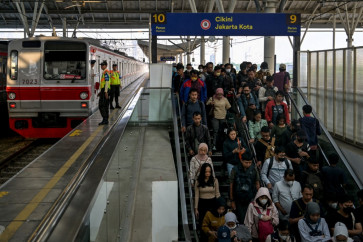Popular Reads
Top Results
Can't find what you're looking for?
View all search resultsPopular Reads
Top Results
Can't find what you're looking for?
View all search resultsIndonesia: The tragicomedy of a food-rich country
Amid the democratic euphoria of the last few years, the Indonesian public has been too busy with issues of corruption and terrorism
Change text size
Gift Premium Articles
to Anyone
A
mid the democratic euphoria of the last few years, the Indonesian public has been too busy with issues of corruption and terrorism. On the sidelines, highly important food issues are often forgotten. According to the Central Statistics Agency (BPS), from January to June 2011, Indonesia imported as much as 11.33 million tons of food, equivalent to US$5.36 billion. This includes 28 types of food, from rice to chili.
Notwithstanding the excessive praise given to Indonesia as a food rich country, these facts should wake us out of our daydream. There has to be something wrong with the country’s behavior and policies regarding food.
After a relatively stable 25 years, global food commodities started to fluctuate in 2004-2005, before reaching their peak in 2008. The cost of rice in 2011 rose threefold, while it was twofold for wheat. Like it or not, we have entered a period where we are awfully prone to food price instability.
In January 2011, the Food and Agriculture Organization (FAO) announced that the December 2010 food prices index reached a record high. The FAO warned that there would be a global food crisis in 2011, worse than the food crisis of 2008. According to FAO (2010), grain production tended to reduce from 2.3 billion tons in 2009, to 2.216 billion tons in 2011. At the same time, its consumption rate keeps on increasing, from 2.181 billion tons in 2009 to 2.253 billion tons in 2011.
Consciously or not, there have been almost 30 years of global homogenization. This period has been marked by public spending cuts, privatization, the removal of tariff barriers and the granting of concession for the private sector. Consequently, almost every country’s food production is systemically opened up and dominated by export-oriented agricultural products. A shock in the global food market will inevitably have a domestic impact.
A more alarming cause comes from speculators playing with the food market after the devastation of America’s stock market. Currently, agriculture companies and giant foreign companies have firm control over the global food chain. These enterprises can create food availability and scarcity issues and can profit from the bump or plunge in food prices.
Indonesia, which still views itself as an agriculture-based country, is ironically still experiencing food problems. Figures reveal that every year Indonesia has to spend Rp110 trillion for the purchase of food commodities from abroad. This number covers about 10 percent of 2011-2012 state budget.
Where does the fault lie in this country? First, it lies in defective policies. So far, the government has always reduced the definition of food to rice, which translates to the prioritization of rice availability. The homogenization of consumption has shattered the nation’s ability to be self-sufficient. Except in 1985, this strategy has failed to fulfill Indonesia’s rice demand.
The minimum attention paid to small-scale farmers is the second fault. It is true that during the New Order administration, farmers felt that more attention was given to them because of extensive subsidies and the support of the regime. Yet, on the other hand, now there are no price incentives and the import tap is widely opened, that the products of small-scale farmers have to compete with industrial products.
The third fault lies in the diversification, a la New Order, that successfully distorted flour price to be sold 50 percent lower than the international price. Consequently, Indonesians crowded around wheat as their second food choice and it even slowly started to replace rice. Import figures continued to rise, from 3.7 million tons in 1998 to 6 million tons in 2010.
Market dependency is the fourth fault. In this world, every country gives serious consideration to managing its food affairs. Japan, the US and the European Union all work to secure their people’s food needs earnestly.
The fifth fault lies in a “trickle down effect”. This concept was trusted by the New Order and it created a situation where incentives were granted for private companies and their cronies. No company orientates itself for domestic food compliance, but for exports and deals that will give huge benefits in the short term. This faulty policy has been adopted by SBY until this very moment, although the new package has been titled “Food Estate”.
This country often does not realize how rich in food sources it is. In our forests alone, for example, we have around 800 species that can be used as food sources. So there is no reason for this country to keep losing on food affairs. If productivity is the problem, the productivity of yam, arrowroot or breadfruit is high enough to be consumed. Even yam can produce 40 tons per hectare.
So is the case with taste and nutrient content. Dozens of products from the three kinds of tubers, such as bread, cakes and noodles, are tasty and filled with all kinds of nutrients. There is no problem with that, then.
It is time for us to ensure the continuity of our nation. One of the prerequisites is food sovereignty. The method is simple, yet it needs good intentions and better political will. Here are some measures for the state to take: first, recover the production capability of small-scale farmers and fishermen by granting incentives and assistance, especially on agrarian resources. Second, food diversification in accordance with local potential.
Third, protect the local food market. Four, restore national food reserves by building granaries on many levels. Fifth, increase public investment in food and agriculture. Sixth, stop granting agriculture areas to big enterprises and put a halt to food production area conversion.
There is no magical recipe to solve a food crisis that persists, except for a commitment from policy-makers and Indonesian consumers to establish sovereignty over our own food resources. Just like a donkey that refuses to fall into the same hole, as a large nation, we reject this prolonged food problem that is caused by the same excuses.
The writer is national coordinator of the Alliance for Prosperous Villages.










